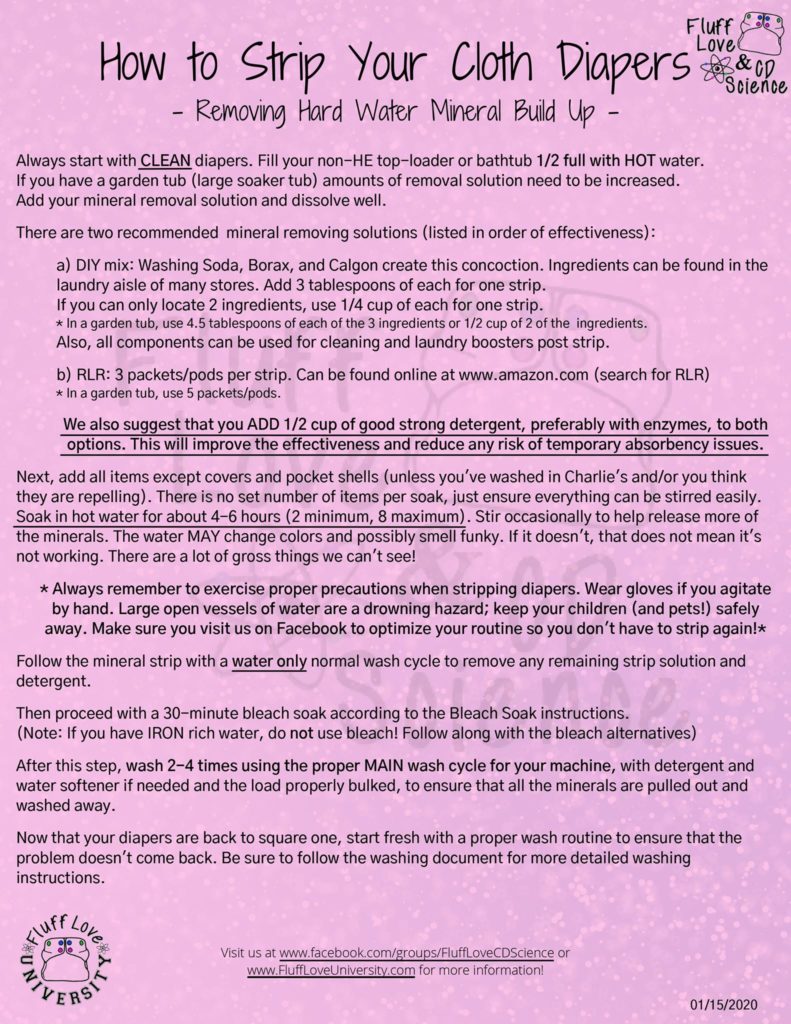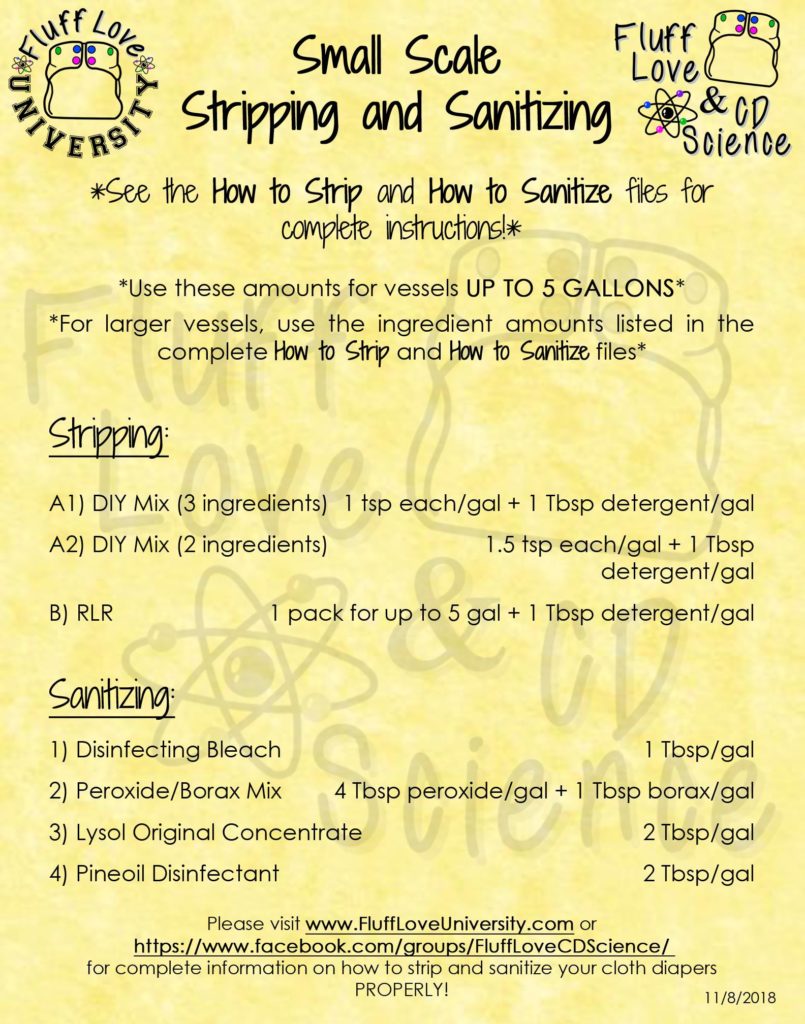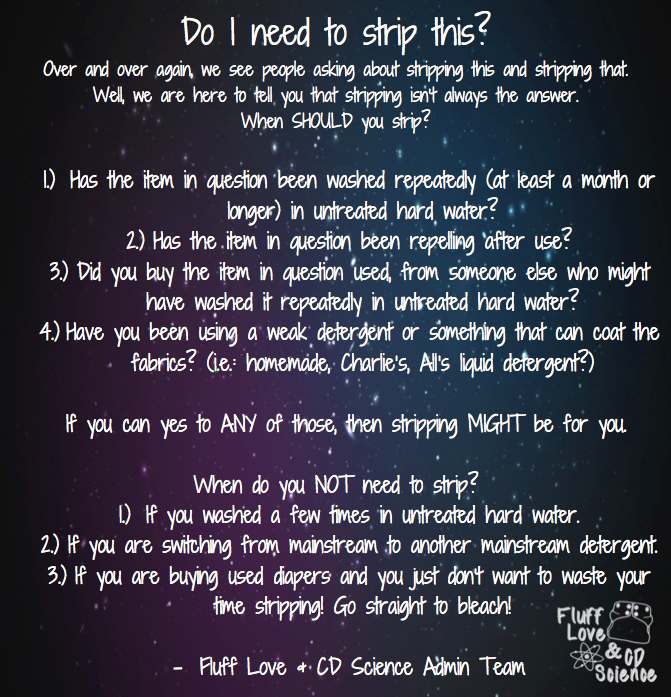Home >> Troubleshooting >> Solving Stinky Diaper Problems >> How to STRIP Your Cloth Diapers
by Jennifer Brock
Washing diapers frequently in untreated hard water can result in several types of problems. Often minerals get trapped in the layers of fabric, which can cling to bacteria or just start to repel, causing your diapers to lose absorbency.
When SHOULD you strip?
1.) Has the item in question been washed repeatedly (at least a month or longer) in untreated hard water?
2.) Has the item in question been repelling after use?
3.) Did you buy the item in question used, from someone else who might have washed it repeatedly in untreated hard water?
4.) Have you been using a weak detergent or something that can coat the fabrics? (i.e.: homemade, Charlie’s, All’s liquid detergent, or frequent use of fabric softener?)
If you can yes to ANY of those, then stripping MIGHT be for you.
When do you NOT need to strip?
1.) If you washed a few times in untreated hard water.
2.) If you are switching from mainstream to another mainstream detergent. (without any previous issues)
3.) If you are buying used diapers and you just don’t want to waste your time stripping! That’s okay! As long as you bleach that is the most important part. If you notice problems after bleaching, then you should revisit stripping.
4.) Non-absorbent diaper pieces, such as covers and pocket shells, don’t generally need to be stripped, as they have no absorbent parts.
OMG! Strip ALL THE THINGS!
Hold on there, Thunder. While stripping diapers is a wonderful tool to help rejuvenate diapers, it is not a gentle process. Extended soaking of diapers is hard on fabric, especially when soaking in such a caustic solution. That’s why we don’t recommend stripping diapers regularly or even frequently. Stripping is not the way you get clean diapers. You get clean diapers with a good wash routine. Stripping is an extreme process used to correct months or years of improper washing, not something you do just for fun. If your diapers are clean out of the wash, there is no need to strip.
One rare outcome of stripping is leaking diapers. Although our survey data reported that 95% of survey respondents experienced no leaking or only temporary leaking, that does not by any means discount the other 5%. As we work to determine the exact cause of the leaks, you should know
- It is generally not necessary to strip pocket shells or PUL covers, as they have no absorbent parts.
- the vast majority of the time, any leaks are temporary and resolved with additional washing with a good wash routine; proper agitation, enough detergent for a heavily soiled load, the proper water level, and using liners or cloth-safe diaper cream are all important to resolving leak issues.
- PUL is water resistant, not water proof. With a strong enough stream of water focused on one spot in the PUL, any diaper will experience leaks, regardless of stripping.
- recently stripped inserts will absorb liquids much more readily than those caked with mineral buildup, coated with scum, or containing unwashed soil. They are also more prone to releasing those liquids more quickly in the form of compression leaks. If you have been double-stuffing diapers prior to stripping, try moving to a single insert to reduce the incidence of compression leaks.
- all normal leaking guidelines apply. Do the diapers fit properly? Is there enough absorbency (are the inserts fully saturated when the leaks occur)? Is it pointed down? Have non-cloth-safe creams been used?
- Leaks are far less frequent when our stripping directions are followed to the letter. Soaking for longer than we recommend or adding extra of the strip ingredients puts even more stress on your diapers, and can greatly exacerbate leaking problems.
Now, HOW do you strip your cloth diapers?
1.) Always start with CLEAN diapers (they do not have to be dry, just clean. Out of the washer is fine.) Generally, you only need to strip absorbent parts, such as prefolds or flats, pocket diaper inserts, or AIOs. Pocket shells and diaper covers rarely need to be stripped.
2.) Fill your top-loader, bathtub, or container ½ full with HOT water (as hot as you can get it from the tap.)
3.) Add in your mineral removal solution and dissolve well.
There are several mineral removing solutions:
a.) DIY mix*: This homemade mixture has awesome success. Washing Soda, Borax, and Calgon create this concoction at around $16.28 for it all at Wal-Mart (in the laundry aisle.) 3 Tablespoons of each for one strip = $0.49 per strip. Also, all components can be used for cleaning and laundry boosters post strip.
(Note: If you are unable to get ALL 3 ingredients, you can mix ¼ cup of two of the three ingredients, OR ½ cup of a single ingredient. HOWEVER, the more ingredients you have, the larger the broad spectrum of minerals being targeted will be.)
b.) RLR*: $2.99 per pack x 3 for one strip = $9 a strip – You can find these on Amazon.
**We also suggest that you ADD ½ cup of good strong detergent, preferably with enzymes. This will improve the effectiveness and reduce any risk of temporary absorbency issues.**
4.) Soak all your items in the water until it cools (at least 2 hours,) or overnight (but no more than 8 hours). Ideally, you will soak between 4 and 6 hours.
5.) Stir the items occasionally to help release more minerals from the fabrics.
The water MAY change colors or get murky. It’s also normal for it to smell slightly unpleasant. However, if your water doesn’t change colors that is okay too! There are plenty of gross things that we can’t see! Don’t worry!
6.) After the water is cool drain the tub, and squeeze all water from the items.
7.) Complete with a WATER ONLY wash cycle. This will make sure all the detergent and mineral solution is out of your fabrics in preparation for the bleach soak to follow.
After the rinse is complete, it is necessary to follow with a 30 minute COLD bleach soak. This will make sure any bacteria (attached to the trapped minerals) that have been brought to the surface are killed. When this step is bypassed, rashes and burns can happen.
8.) After your bleach soak, its recommended to wash everything 2-4 times. These back to back normal wash cycles will ensure that all the minerals are pulled up and rinsed away.
The directions for the bleach soak are found in How To BLEACH Your Cloth Diapers.
Now that your diapers are back to square one, be sure to start fresh with a proper wash routine. Pre-wash, wash with detergent and water softener, then dry.
For detailed instructions, follow How to PROPERLY CLEAN Your Cloth Diapers– Non-HE.
How to Properly Clean Your Cloth Diapers – HE
Keep in mind that properly cleaned diapers should never need to be stripped. If you find yourself needing to strip your diapers, it’s time to adjust something in your wash routine (detergent amount or type, water level, etc.)

If you don’t have access to a top loader, tub or container over 5 gallons, you can use our small scale stripping and sanitizing guide

Read more about hard water.
http://extoxnet.orst.edu/faqs/safedrink/hard.htm
http://www2.ca.uky.edu/agc/pubs/ip/ip7/ip7.htm
Read about water pH.
Join the discussion on the Fluff Love & CD Science Facebook page.

